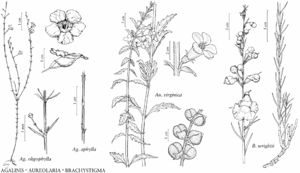Difference between revisions of "Agalinis tenella"
Bull. Torrey Bot. Club 40: 434. 1913.
FNA>Volume Importer |
FNA>Volume Importer |
||
| Line 34: | Line 34: | ||
|elevation=0–70 m. | |elevation=0–70 m. | ||
|distribution=Ala.;Fla.;Ga.;S.C. | |distribution=Ala.;Fla.;Ga.;S.C. | ||
| − | |discussion=<p>Agalinis tenella is common in the panhandle of Florida, adjacent Alabama, and east-central Georgia, and occasional in southern South Carolina. J. B. Pettengill and M. C. Neel (2011) showed A. tenella to be most closely related to the rare A. decemloba. Agalinis tenella is distinguished from A. decemloba (including A. acuta) by the laxly and widely spreading branching habit, generally much shorter calyx lobes, larger corollas, and truncate capsules of A. tenella. Agalinis tenella can also be confused with A. obtusifolia; A. tenella has well-formed racemes usually with two flowers per node, while the inflorescence of A. obtusifolia is paniculate and has short, slender branches each appearing to terminate in a pedicelled flower subtended by tiny bractlets.</p> | + | |discussion=<p><i>Agalinis tenella</i> is common in the panhandle of Florida, adjacent Alabama, and east-central Georgia, and occasional in southern South Carolina. J. B. Pettengill and M. C. Neel (2011) showed <i>A. tenella</i> to be most closely related to the rare <i>A. decemloba</i>. <i>Agalinis tenella</i> is distinguished from <i>A. decemloba</i> (including A. acuta) by the laxly and widely spreading branching habit, generally much shorter calyx lobes, larger corollas, and truncate capsules of <i>A. tenella</i>. <i>Agalinis tenella</i> can also be confused with <i>A. obtusifolia</i>; <i>A. tenella</i> has well-formed racemes usually with two flowers per node, while the inflorescence of <i>A. obtusifolia</i> is paniculate and has short, slender branches each appearing to terminate in a pedicelled flower subtended by tiny bractlets.</p> |
|tables= | |tables= | ||
|references= | |references= | ||
| Line 58: | Line 58: | ||
|publication year=1913 | |publication year=1913 | ||
|special status=Selected by author to be illustrated;Endemic | |special status=Selected by author to be illustrated;Endemic | ||
| − | |source xml=https://jpend@bitbucket.org/aafc-mbb/fna-data-curation.git/src/ | + | |source xml=https://jpend@bitbucket.org/aafc-mbb/fna-data-curation.git/src/8f726806613d60c220dc4493de13607dd3150896/coarse_grained_fna_xml/V17/V17_986.xml |
|genus=Agalinis | |genus=Agalinis | ||
|species=Agalinis tenella | |species=Agalinis tenella | ||
Revision as of 15:05, 18 September 2019
Stems simple or branched, 25–90 cm; branches laxly and widely spreading, subterete proximally, quadrangular-ridged distally, glabrous or scabridulous. Leaves spreading; blade filiform to linear-filiform, 6–25 x 0.2–1(–1.5) mm, margins entire, often siliceous, abaxial midvein sometimes scabridulous, adaxial surface finely scabrous; axillary fascicles absent. Inflorescences racemes, flowers 2 per node, sometimes with branches bearing pseudoterminal flowers; bracts shorter than pedicels. Pedicels spreading, (7–)10–25(–30) mm, glabrous. Flowers: calyx obconic to hemispheric, tube 2–3 mm, glabrous, lobes subulate, 0.2–0.4 mm; corolla pink to rosy pink, with 2 yellow lines and red spots in abaxial throat, 10–17 mm, throat pilose externally and villous within across bases and sinus of adaxial lobes, lobes: abaxial spreading, adaxial erect to strongly recurved, 4–7.3 mm, glabrous externally; proximal anthers parallel to filaments, distal perpendicular to filaments, pollen sacs 1.7–2.5 mm; style exserted, 7–9 mm. Capsules ovoid-globular, 3–3.7 mm. Seeds yellow, 0.7–1 mm. 2n = 26.
Phenology: Flowering Sep–Oct.
Habitat: Dry sandy to mesic pine savannas, margins of pine plantations, mixed open woodlands and oak-pine scrub, open pine-palmetto palm woodlands, ditch banks, sandy embankments, roadsides.
Elevation: 0–70 m.
Distribution
Ala., Fla., Ga., S.C.
Discussion
Agalinis tenella is common in the panhandle of Florida, adjacent Alabama, and east-central Georgia, and occasional in southern South Carolina. J. B. Pettengill and M. C. Neel (2011) showed A. tenella to be most closely related to the rare A. decemloba. Agalinis tenella is distinguished from A. decemloba (including A. acuta) by the laxly and widely spreading branching habit, generally much shorter calyx lobes, larger corollas, and truncate capsules of A. tenella. Agalinis tenella can also be confused with A. obtusifolia; A. tenella has well-formed racemes usually with two flowers per node, while the inflorescence of A. obtusifolia is paniculate and has short, slender branches each appearing to terminate in a pedicelled flower subtended by tiny bractlets.
Selected References
None.
